LAST EDITED ON Feb-09-16 AT 08:50 PM (EST)
originally "Next Gun of the Week coming soon"...but, well, not right now, because...

... it literally just arrived. :)
Stay tuned!
OK! Here it is.
This week's Gun of the Week was delayed slightly by the need for it to actually arrive here at the Fortress of Solitude, but now that it has, I think you'll find it interesting.
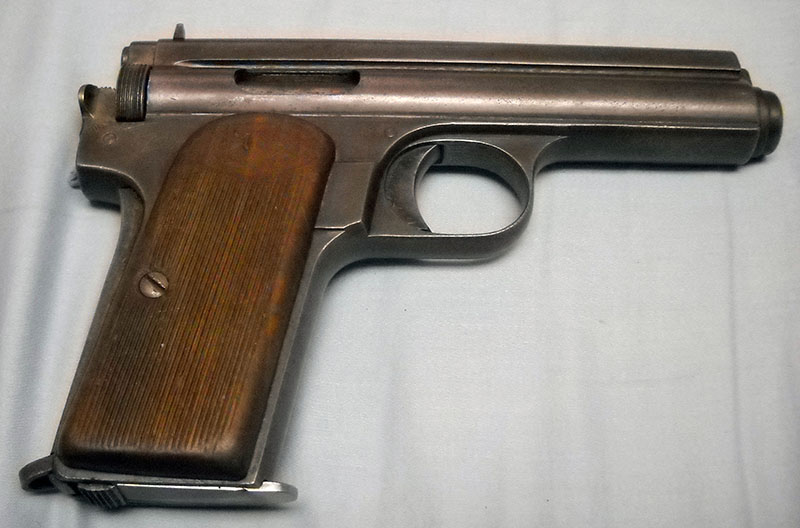
This is a Stop pistol, also known (after its Royal Hungarian Army ordnance designation) as a Pisztoly 12M. Although it was manufactured by the old and well-regarded Hungarian firm of FÉG (which, at the time this pistol was manufactured, stood for—brace for incoming diacriticals!—Fegyver-és-Gépgyátó Részvéntársaság, "Arms and Machine Manufacturing Company"), it is much more commonly identified today with the name of its designer, Rudolf Frommer, and so is pretty much universally described as a "Frommer Stop". (You will occasionally see this rendered "Frommer-Stop" or even "Frommer-STOP", as if it were an acronym, but it is in fact just a slightly precious marketing reference to the fact that it's meant to stop assailants.)
The Stop is one of the legion of small .32-caliber self-loading pistols that came out of Europe in the early 20th century, but it's one with a couple of differences—differences that, for my money, make it one of the most interesting of the early 20th century's automatics, if not the most interesting.
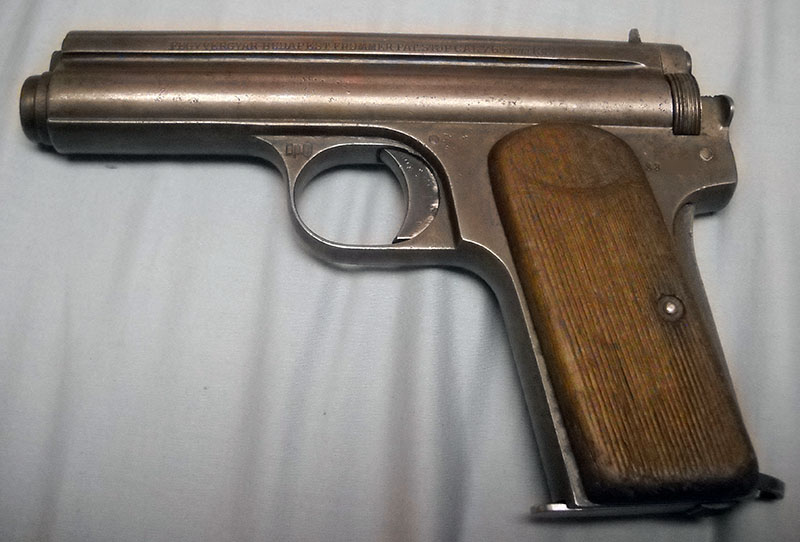
First, a little history. When this pistol was adopted by the Hungarian army in 1912, Hungary was not an independent country. Or it was. It's all in how you interpret the weird, wild political structure of that doddering colossus of central Europe, the Austro-Hungarian Empire.
People remember the Austro-Hungarian Empire today, when they remember it at all, as one of the key actors in the start of World War I: it was the June 1914 assassination of an Austrian royal, and Austria's subsequent decision to invade neighboring ancient rival Serbia (whence the assassins had been organized), that kicked off all the ridiculously complicated and stupidly mismanaged political and military hardware that led, by the end of August, to the war.
It's notable for a great many things besides that, though, and most of them are well outside the scope of this document. For our purposes, the thing about the Austro-Hungarian Empire was that it was effectively two nations* with one ruler. The Empire was legally a "dual monarchy", meaning that (in 1914) Emperor Franz Josef had two capitals and two courts, one in Vienna and one in Budapest, and ruled through two separate bureaucracies with two separate codes of law.
Which meant, among other things, that the Austrian Army and the Hungarian Army were not the same army, even when Austria-Hungary was legally one country. Hungary maintained its own arms industry, its own ordnance system, and all that went with it, so while the Austrian side of the coin was adopting the Steyr Model 1912 (commonly known as the Steyr-Hahn), the Hungarians insisted on their own home-grown sidearm. That sidearm, in that same year, was the Frommer Stop.
Now then. I said that this was one of the most interesting of the early 20th century's legion of .32-caliber pistols, and I meant it. Here is the principal reason why: its action. The Stop has what is known in the business as a long-recoil action. We've seen blowback and short recoil in previous entries. Long recoil is a more elaborate system, one in which the barrel and bolt travel backward together, then the barrel comes forward to extract the empty, then the bolt follows it forward to pick up the next round and return to battery.
There's no really good way to show this in still photos, particularly if you only have two hands and need one of them to operate the camera, although you can at least see in the shot of the right side that the ejection port seems oddly far back (compare to the relative position of the port on the Colt 1903 Pocket Hammerless or the Hi-Power). Ian at Forgotten Weapons has a short slo-mo video showing a Stop's long-recoil system in action, and here is a photo of the business end, clearly showing the separate barrel inside its shroud.
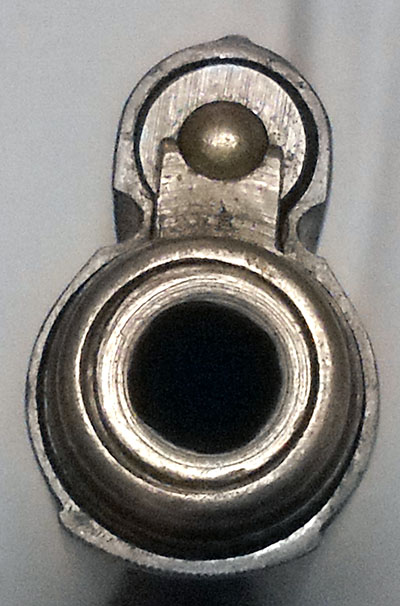
Here's the thing: long-recoil action, with its attendant bolt locking system, is the kind of thing you need for really powerful cartridges. Gabbett-Fairfax Mars pistols were long-recoil, because they were essentially tiny naval artillery pieces. John Browning's Auto-5 shotgun was long-recoil, because that was the best way he could think of to contain something like the power of a 12-gauge shotgun shell in a self-loading mechanism.
The Stop? Is a .32 pocket automatic. As we have previously seen, simple spring-and-inertia blowback is more than adequate for that. Even though the 7.65mm Frommer cartridge was more powerful than .32 ACP (more on this in a moment), there was no need whatever to make such a tiny pistol with such an amazingly complicated and secure operating system.
And it is tiny. Check this out. I admit I don't possess the planet's daintiest meathooks, but still:
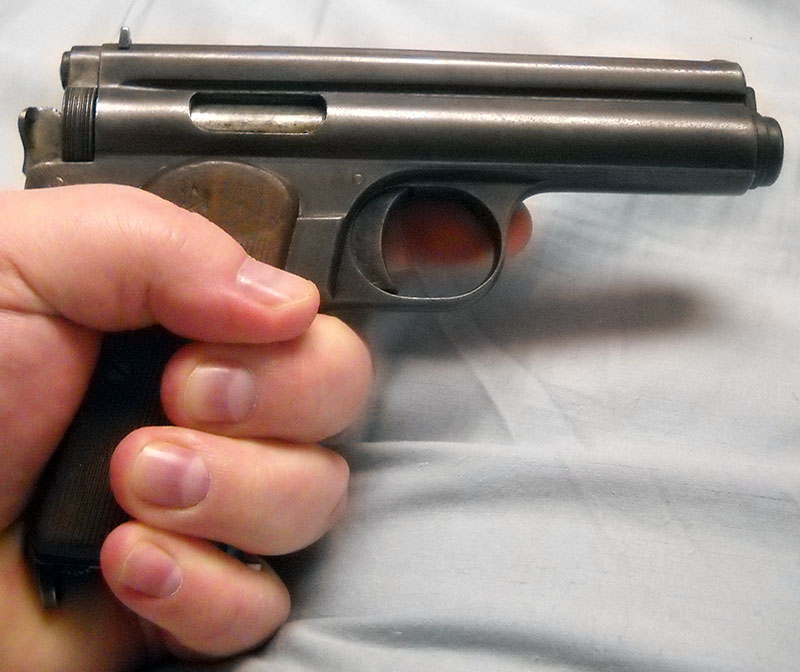
Look at the gap between my ring and pinky fingers. That's the tip of the magazine floor plate peeking out there. I could be in the teacup pinky-out position and it would make no difference to my grip on the Stop. It is a tiny, tiny pistol. And yet Frommer designed it with a locking system that wasn't out of place on a 12-gauge autoloading shotgun.
The going theory as to why he did this was that he anticipated parlaying the Stop's success into a whole family of self-loading pistols, the larger members of which would actually need such an elaborate operating system. In the event, it never really happened; a later variant of the Stop was available in a cartridge comparable to 9mm Kurz/.380 ACP, but that was as far as it went.
Speaking of which, as I mentioned above, another interesting thing about this is that while you will almost always see it described as a 7.65x17mm Browning SR/.32 ACP pistol, it isn't really. 7.65mm Frommer had the same geometry, but specified a larger powder charge. This made it more formidable ballistically, but also opened up the possibility of problematic mix-ups, since that meant Frommer ammunition would chamber and function just fine in pistols meant to fire regular 7.65mm semi-rimless cartridges, but could produce pressures that those pistols could not necessarily handle safely.
Nowadays, nobody makes 7.65mm Frommer ammunition, so that potential problem is pretty much no more, but on the flip side, I've seen reports that the Stop won't work reliably with most commercial .32 ammo on the market today. It's perfectly safe to shoot underpowered ammunition, I mean, it's not as if modern .32 is so wimpy the bullet won't clear the muzzle or anything, but semiautomatics need a certain level of power to function properly, and evidently Stops sometimes have failures to extract or eject using it. (Of course, if you load your own, that's not an issue; just keep it away from your other .32s.)
One side effect of the Stop's absurd complexity is that it's... non-trivial... to dismantle. Remember I said that the Colt 1903 Pocket Hammerless kind of needs three hands to take down? Well, the Stop takes four or five, and offers at least three opportunities to launch spring-tensioned parts across the room or into your eye. I am therefore not going to take mine apart for this article. However, the nice folks over at C&Rsenal braved the horrors already, so you can take a look at their findings if you're interested.
We can also get a closer look at how the Stop works thanks to the diagrams on page 345 of Ezell's Handguns of the World. (Apologies for the slightly distorted photo; the book is too big to put in my scanner.)
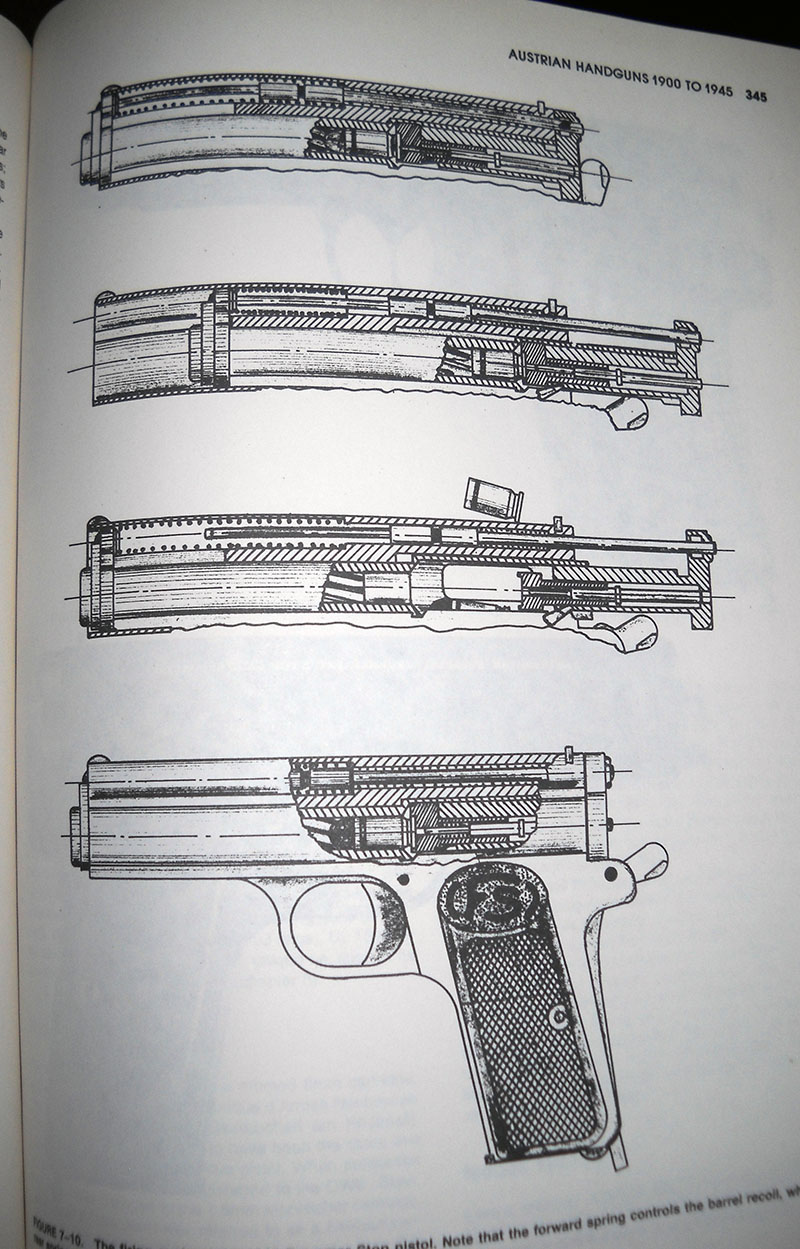
Unlike its Austrian counterpart, the Steyr-Hahn (which uses a fixed internal magazine charged with stripper clips), the Stop has a modern detachable box magazine. Like most small automatics so equipped at that time, it has a heel release, which is a moderate pain to operate.
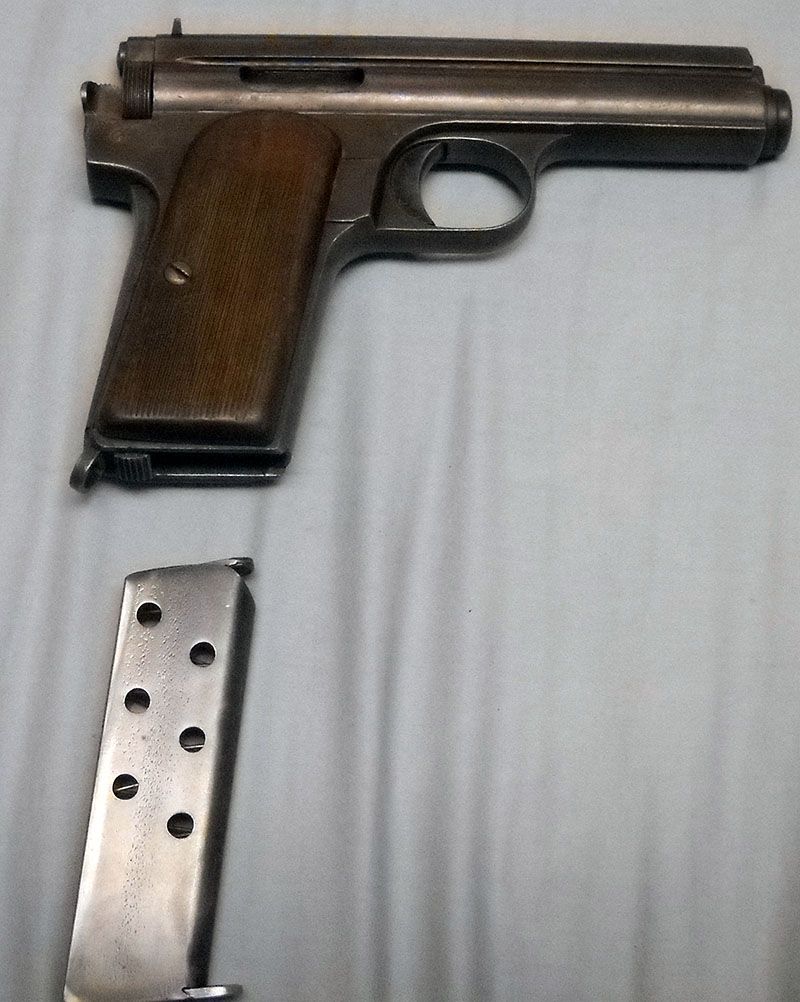
Interestingly, the lanyard loop at the heel of the grip swivels, but only through about 90 degrees. It can't fold up flat against the backstrap.
The Stop has a single-action trigger actuating that little tiny hammer you can see behind the bolt cocking knob in the side views. It has a spring-loaded grip safety, not unlike that found on (for instance) the Pocket Hammerless, but no other external safety. There is no decent way of decocking it, either. Once you've charged this pistol, you had best be planning on firing seven rounds. It also has the usual teeny-tiny 1910s pistol sights, so best of luck!
All this gun's markings are on the left side, so we only need one picture to have a closer look at them.
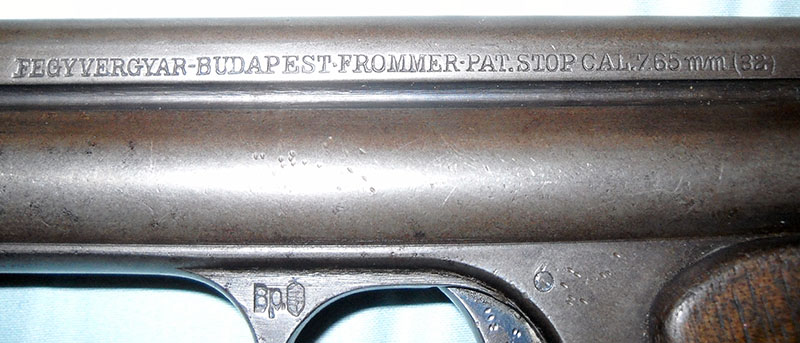
FEGYVERGYAR is a shortened form of FÉG's full name; I'm not sure why there are no accents on the gun itself, maybe they didn't register their font. You can see here that it's labeled "FROMMER-PAT."—that is, "Frommer's patent", a way many guns based on patents licensed from their designers were labeled in those days. Also visible in this shot is the Hungarian government's proof mark, on the front web of the trigger guard: that says "Bp." (short for Budapest and then a tiny version of the Hungarian national crest.
The grips originally had the FÉG logo on them—you can see the spots where it used to be, at the top of each panel—but they have long since worn off on mine. Earlier Stops had molded plastic grips, which presumably have held up better than the wooden ones fitted later. According to the Internet, my particular Stop was manufactured in 1922. The Budapest proof house stopped dating its proof marks on Stops during that year, so this one must have been made fairly late in the year's production run (otherwise the proof mark would say "Bp. (crest) 22").
So! The Frommer Stop. A deeply odd, unnecessarily baroque, strangely charming little gun, even by the widely varied standards of that strange and exciting period in firearms design. I've wanted one of these things for years, ever since I saw it mentioned in a magazine article about The Weird, Weird Guns of the Austro-Hungarian Empire**, and now I've got one. Steyr-Hahn and Roth-Steyr probably to follow sometime (in the Roth-Steyr's case, probably not anytime real soon, on account of they're rather rare and valuable now). Very pleased to be able to share it with y'all.
--G.
* This doesn't take into account all the various other ethnic and national groups who were part of the Empire on account of having been conquered by either Austria or Hungary... but rest assured, there were a lot of those. This is why that part of Europe is still pretty much completely screwed up a century later.
** Unfortunately not the article's actual title.
-><-
Benjamin D. Hutchins, Co-Founder, Editor-in-Chief, & Forum Mod
Eyrie Productions, Unlimited http://www.eyrie-productions.com/
zgryphon at that email service Google has
Ceterum censeo Carthaginem esse delendam.

 Printer-friendly copy
Printer-friendly copy












